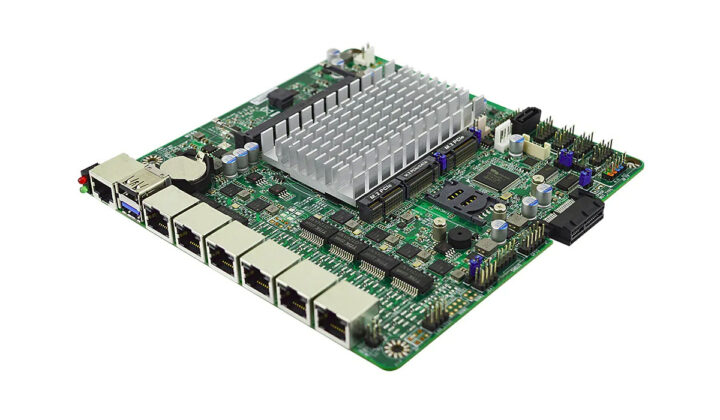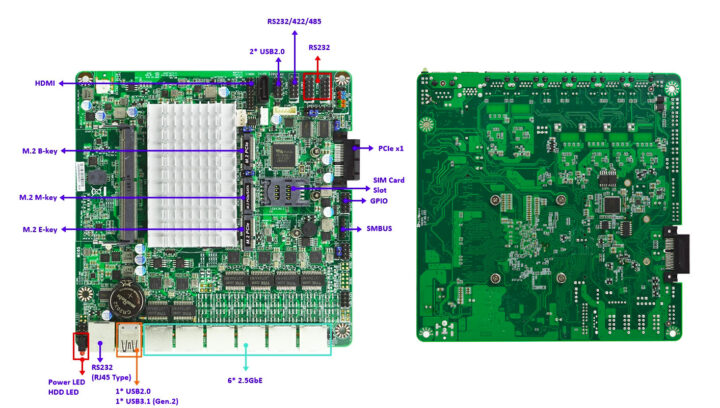Powered by an Intel Celeron J6412 quad-core Elkhart Lake processor, the Jetway MI05-0XK thin mini-ITX networking board is equipped with six 2.5GbE ports, up to 16GB RAM via a single SO-DIMM socket, as well as M.2 sockets for storage, WiFi and/or cellular connectivity, some serial ports, and an optional HDMI port for video output.
Four variants are offered: the standard MI05-00K model without eMMC flash nor TPM, the MI05-02K with a TPM 2.0 chip, the MI05-03K with a 32GB eMMC flash, and finally the MI05-07K with both the TPM 2.0 security chip and 32GB eMMC flash.
 Jetway MI05-0XK specifications:
Jetway MI05-0XK specifications:
- SoC – Intel Celeron J6412 quad-core Elkhart Lake processor @ 2.0 GHz / 2.6GHz (Burst frequency) with 1.5MB cache, 16 EU Intel UHD Graphics; 10W TDP
- System Memory – Up to 16GB DDR4-3200 via SO-DIMM socket
- Storage
- 1x SATA III (6 Gb/s) port
- 1x M.2 M-key 2242 SATA/PCIe Gen.3 x2 interface for SATA or NVMe SSD
- Optional 32GB eMMC flash
- 128 Mbit flash for AMI BIOS
- Video Output – HDMI 1.4b header up to 3840×2160 @ 30Hz to connect HDMI port if needed
- Networking – 6x 2.5GbE RJ45 ports via Intel i225-V controllers
- USB – 1x USB 3.1 Gen 2 port, 1x USB 2.0 port, 2x USB 2.0 interfaces via header
- Serial
- RS232 RJ45 port
- 1x RS232/422/485 header
- Header with 2x RS232
- Expansion slots
- 1x M.2 E-key 2230 socket with USB2.0/PCIe Gen.3 x1 interfaces
- 1x M.2 B-key 3042 socket with USB3.1 interface
- 1x PCIe x1 horizontal slot
- Misc – Power LED, HDD LED, SMBUS header, GPIO header, PS/2 header, Watchdog timer
- Power Supply – 12V DC-in; AT: Directly power on; ATX: Press Button to power on
- Dimensions – 170 x 170mm (thin mini-ITX form factor)
- Compliance – CE, FCC, RoHS, REACH
- Temperature Range – Operating: 0°C to 60°C; storage: -20°C ~ 60°C
- Humidity – 10% to 90% RH @ 40°C (non-condensing)
Jetway says the thin mini-ITX networking board support Windows 10, Windows 11, and Linux, and recommends models with the 32GB eMMC flash to boot Windows 10 for some reasons… Looking into the datasheet, we find a longer list of operating systems, even adding some BSD distributions with Win10 64-bit, Win 10 IoT Enterprise 64-bit LTSC 2019, CentOS (Version 9), Debian (Version 11.3), Fedora LXDE, Workstation, or Server (Version 36.1.5), OpenSUSE (Version 15.4), Ubuntu 22.04 Desktop/Server, pfSense (Version 2.6.0), TrueNAS (FreeNAS) (Version 13.0), RedHat Enterprise (Version 9.0), and OPNSense (Version 22.1.2).
It’s not the first time we write about a thin mini-ITX motherboard for networking applications, and the BCM Advanced Research MX6412J is also based on an Intel Celeron J6412, but only offers two Gigabit Ethernet ports plus two 2.5GbE ports, instead of the six 2.5GbE ports on the Jetway board. On the plus side, it comes with two SO-DIMM sockets for up to 32GB RAM, instead of just 16GB for the MI05-0XK board.
The Jetway MI05-0XK series motherboards are available now, and the Jetway MI05-00K model can be purchased for $299.95 on the MITXPC store based in the US. Further information may also be found on the product page.
Via LinuxGizmos

Jean-Luc started CNX Software in 2010 as a part-time endeavor, before quitting his job as a software engineering manager, and starting to write daily news, and reviews full time later in 2011.
Support CNX Software! Donate via cryptocurrencies, become a Patron on Patreon, or purchase goods on Amazon or Aliexpress





